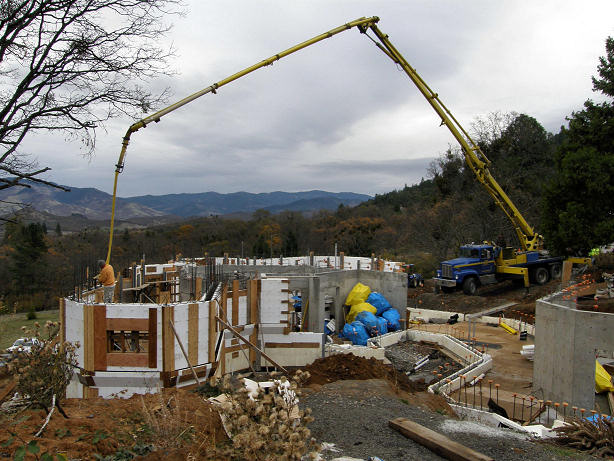We decided to use Insulated Concrete Forms for the exterior basement walls. This is a fairly new technique for building concrete walls, but is catching on rapidly. They are large blocks consisting of two 2"-thick Styrofoam sheets separated by plastic ribs. They are stacked up like cinderblocks, then poured full of concrete.
There are several wall thicknesses available, determined by the length of the ribs. For the theater area, we used blocks with a 12" concrete core for a total wall thickness of 16". Walls in less critical areas were thinner.
 Blocks were stacked, and lots of rebar was inserted, both horizontally and vertically. Wooden bucks were made for places where openings were needed. These will remain in place, and the window and door frames will screw into them later. Metal braces and plywood hold the walls straight and vertical during pouring, which can get pretty violent.
Blocks were stacked, and lots of rebar was inserted, both horizontally and vertically. Wooden bucks were made for places where openings were needed. These will remain in place, and the window and door frames will screw into them later. Metal braces and plywood hold the walls straight and vertical during pouring, which can get pretty violent.
We used Eco brand blocks, because our contractor was familiar with them, but if I had it to do over again, I might have chosen a different brand. Eco Blocks work fine on straight sections and 90-degree corners, but nearly all my corners were 45-degrees. The corners all had to be hand-cut, then held in place with plastic sleeves. These were a weak point during cement-pouring, and some of them buckled slightly. Other brands of ICF have pre-cast 45-degree corners which should eliminate this problem.
The concrete for the walls was pumped in using a crane pump. This is a little more costly than using a regular hose pump, but not much. It's practically vital for pouring the fragile ICF blocks, and allows the cement to be placed with great precision. Concrete vibrators are inserted into the wet cement to ensure that it flows into all the nooks and crannies. ICF blocks simplify construction in several ways. They can be put in fairly quickly by a very small crew (often just one guy!). They have a high R-Value, and no further insulation is generally needed. The exterior is smooth and can be waterproofed fairly easily with a peel&stick membrane. The interior is ready to take drywall - just screw it into the plastic ribs, which are spaced every 8 inches and hold screws extremely well. It's easy to cut holes and grooves in the Styrofoam for switchboxes and wiring.
While the ICF walls were going up, work was also being done on the interior walls of the basement. These are all just 8"-thick concrete, but the wooden forms were fairly complex and slow to build. There were also electrical conduits which had to be embedded in them.
These walls were also poured with the sky crane pump.
At the same time, the remainder of the floors were being poured. With the different levels for stadium seating, the theater floor was a bit of a challenge, and took a lot of concrete. There were times when five cement trucks would be lined up on the driveway, waiting to deliver their loads.
Like nearly everything in this house, the ICF work stretched the knowledge and abilities of the contractor to the limit. In addition to the 45-degree corners, there were other highly unusual features like this round metal buck for a future underwater window in the gameroom.
Finally, all the basement walls were up, and we could start on the main floor.







Jim, is this lot fully serviced? As in water, sewer, telephone,internet, cable? Or will you be needing to develop your own septic field, drill for water etc?
ReplyDeleteWill your geothermal transfer station be inside the house or will you be making a utility shed where all the pumps and heat exchangers live.
No, the lot has no services. We had to put in a well and septic system. I'll cover these in a later post. Phone lines (with DSL) were bundled with the underground electric feed, but there's no cable available. We'll need a satellite dish.
ReplyDeleteThe geothermal system will be housed in an equipment-room in the basement.
How can I contact the supplyer of the blocks?Thanks
ReplyDeleteTheir website is: http://www.eco-block.com/
DeleteFor manufacturing technology Styrofoam block. Block dimensions 3000x1000. What kind of technology so far no one has applied. For patent.
ReplyDeletewww.niskoenergetskekuce.in.rs
www.niskoenergetskekuce.blogspot.com